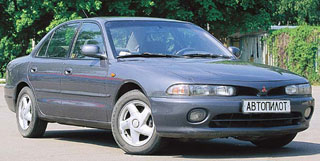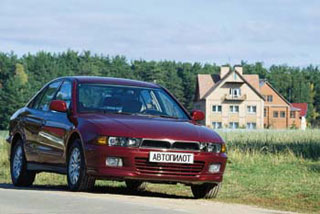Test drive Mitsubishi Galant 1997 - 2004 sedan
A masterpiece of moderation
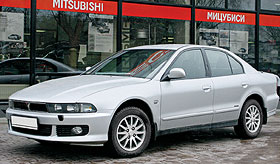 Japanese BMW
Japanese BMW Each automobile company has its own methods for the struggle for buyer wallets. Mitsubishi followed the path of creating passenger models located on the border of classes. For example, our today's hero, Galant, looks like his boyfriend in the company of Toyota-Kamri and Nissan-Maxim-solid representatives of the business class. Although in size and, most importantly, in price, only a few surpasses the Avensis and example.
Galant has another trump card not characteristic of Japanese cars - a bright appearance. Five years ago, barely appearing in Europe, the current Galant received the nickname of the Japanese BMW. The predatory expression of the muzzle, humpbacked hood, embossed sides - aggressive -dynamic, it really looks like a thoroughbred Bavarian horse. To match appearance and riding qualities. Galant demonstrates excellent dynamics (especially with the V6 motor) and a reliable front -wheel drive nature of controllability. If you need a car with a sports image that can give pleasure from driving, it is worthwhile to take a closer look.
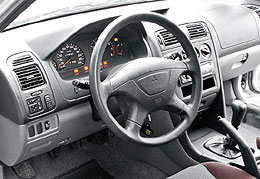 All inclusive
All inclusive Like most Japanese cars, gallants are sold around the world, and the machines intended for various sales markets can differ significantly in design, equipment and even have different names. For us, those that were brought from Europe are preferable to us or were sold by Russian official dealers. The latter worked so actively that galants with local registration largely determine the weather in the secondary market.
Galant's equipment is compiled according to the traditional Japanese system all inclusive. It may vary somewhat depending on the country for which the machine is intended, but depends on the engine to a greater extent. Galants are delivered to Russia and most European countries with a 2-liter 4-cylinder engine and a 2.5-liter V6. In 2-liter machines there are at least two airbags, ABS and an electric package. In the Russian specification, air conditioning is added to this list, not mandatory for Europe. Cars with the V6 engine are equipped richer - cast discs, climatic, and if the cabin is leather, then still side pillows, electric drive and heating seats.
Richly equipped cars should not be afraid. Unlike European cars, an abundance of electronics and servo drives in the salon of a used galta does not bode problems. Yes, it happens that heating the chair, an electric motor adjusting the mirror or some other trifle. But these are isolated cases. If you find fault, you can only note the creaks in the area of \u200b\u200bthe rear racks of the sedan body and the fifth door of the station wagon inherent in almost all galants.
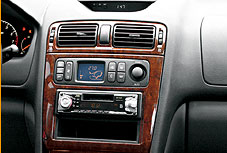
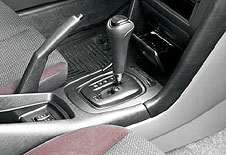
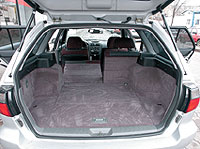
The body itself must only be checked for the presence and quality of the body repair. If everything is in order with this, corrosion should not even reach the earliest copies that have experienced five salted Moscow winters. Over time, only the air conditioner and the generator, who regularly take mud baths under the hood, gets.
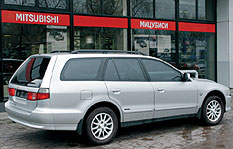 Dirt - air conditioning enemy
Dirt - air conditioning enemy The motor compartment of the galant from below is covered with plastic dirty aprons. In winter, they remain in snowdrifts and dirt begins its black deed, after a year or two, cooling the coupling of the air conditioner. The symptom is a howling sound from under the hood that disappears when the A/s button is turned on. About the same amount with torn aprons lives a generator. It is useless to change the aprons - fly off one or two. It is better to immediately install a wide steel engine protection. And the crankcase will be more purpose, and hinged units from the flows of dirt are covered.
Unfortunately, it is impossible to protect yourself from dirt entering through a radiator grill. It accumulates around the air conditioner laid under the battery, causing its corrosion, and clogs the radiators. The refrigerant is not properly cooled, the pressure rises in the highway and the air conditioner compressor fails. Therefore, the general requirement to annually cleanse the air conditioning and engine radiators for gallant.
How much is
Replacement of the coupling $ 280 $ 410 replacement of the tube $ 80 compressor replacement $ 1660
The nature of the galant is determined by the engine
It is most clearly revealed with the solid and noble V6. Great motor. Having only 163 power forces and 2.5 liters of volume, it competes on equal terms with 200-horsepower 3-liter sixes, accelerating the galant with a manual box up to 100 km/h in just 8.2 s. Real rocket. At the same time, V6 is very beneficial when buying, since it fits into the customs category up to 2500 cm3. When importing to Russia for Galant-V6, you need to pay 2000 euros (or twice!) Less than 3-liter Maxim and Kamri. It is clear that a powerful six allows herself to swallow the excess from the tank (up to 15 l/100 km), and in maintenance it costs more than a 4-cylinder engine. But with this engine, the form of Galant comes into full compliance with the content.
When the motor is stronger than the transmission
Any of the engines is combined with both manual and automatic gearboxes. Usually both boxes of complaints do not cause. Problems can arise with a powerful V6 if you abuse traffic lights.
The mechanics on Galant, as they say, talkative. At idle speeds, light noise and tapping from its bowels come from its bowels. This is a normal phenomenon. But if the noise background is present when moving in transmissions and changes its tonality when feeding/discharge of gas, it means that the bearings of the primary and secondary shafts of the box are worn out. On 2-liter machines, this indicates a run for 150,000 km, and on V6 with aggressively driving bearings can walk earlier. In order to delay the bulkhead of the box as much as possible, do not forget to change the oil in it, as expected, after 60,000 km.
Clutch, depending on the engine and driving style, serves an average of 80,000-120,000 km. If after a hundred thousand it has become poorly turned off, check the main clutch cylinder. Flowing? Put a new one and do not lose time to attempt to repair the old one.
The adaptive automatic box invezi-II is characterized by logical work and soft switching. The automatic machine, provided that the oil is replaced by timely 45,000 km (the SP-II/SP-IM standard oil is allowed) and the correct handling is quite reliable. True, some particularly hot owners of the V6 manage to break the hydrotransformer.
This usually happens either at starts with a screech of rubber, or when an accelerating car from a slippery area flies out onto dry asphalt. At the same time, the frantically shifting wheels are instantly slowed down to real speed, and the powerful V6 cuts down the hydrotransformer slots. If this happens, the hydrotransformer can be searched for Japanese showdown, since the gallant in your homeland is equipped with exactly the same automatic.
How much is
Clutch replacement of $ 460 replacement of the chief clutch cylinder $ 160 Hand gearbox Boam $ 450-750 replacement of the hydrotransformer with a new $ 1730
The supporters of the principle of reasonable sufficiency are addressed to a 2-liter 136-horsepower four. Of course, you will feel that the last two power numbers have changed places compared to V6. However, a 2 -liter engine is also not a mistake. In any case, you will not complain with a manual box about a lack of power. At the same time, it is noticeably more economical than V6 and less loads the suspension and transmission. Let's just say: if you do not consider a hurricane V6, then a 2-liter engine can be recognized as optimal for gallant without reservations. The main thing is that it does not turn out to be carburetor. Such cars were supplied to Arab countries.
Do not run into Arab!
Carburetor engines were supplied to the Arab countries and at one time were actively sold with us with gray dealers. The carburetor is complex and moody. Periodically, it must be disassembled, cleaned and adjusted. Work requires high qualifications, and you will not find a good specialist day with fire. In addition, carburetor engines configured for a hot climate are poorly launched in the cold. As soon as the temperature drops in minus 20, in the morning at the gates of the technical centers of Mitsubishi, evacuators with Arab galants are built. They reanimate them as follows: put in a warm box and give them to the owner in the evening. If the next morning warms up, the client does not return.
Japanese engines are traditionally reliable and durable. Unlike European ones, they do not eat oil, do not snort and do not suffer from control electronics. If the galant motor is timely and qualified to serve, unscheduled costs are likely to be avoided.
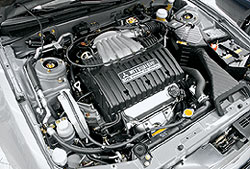 Galant cannot spoil the oil
Galant cannot spoil the oil Oil, on the engines of gallant, are carried out after 15 thousand kilometers. Moreover, the banal requirement not to save in oil in this case has far from abstract meaning. The fact is that the galant engines are equipped with valve hydraulic compensators. They are the first to respond to low -grade or old oil, as well as to its insufficient level. Even considering that they usually begin to knock 4-6 pieces, their identification and replacement will cost $ 250-300. How many cans of good oil can you buy with this money?
In addition, in our conditions, it is advisable to rinse the injectors on a special installation every 30,000 km and annually clean the radiator from dirt. But these are also common truths. The timing belt on both motors is ordered to change after 90,000 km. Moreover, rollers and tensioner (here's a demonstration of Japanese quality) is usually enough for two belts. Now - particular.
On a 2-liter engine on almost everyone, then you will have to change candles. On our gasoline they do not live longer. When the time for replacing the timing belt comes, the mechanic will also have to change the belt of the balancer shafts (which is often forgotten) and install it correctly. Not a replaced or tattered balancing belt breaks and falls under the timing belt. The result is the destruction of the motor
Replacing candles on the V6 engine is a time -consuming work, since this requires to remove the intake manifold. This design is explained by the fact that on V6 expensive platinum candles are used for a long service life. Alas, in our conditions they nurse a maximum of 30,000 km. The collector must be installed carefully. If the mechanic pulls the bolts of its fastening (the collector body is silumin), you will have to buy a new part.
How much is
Replacing candles 2.0/v6 $ 31/120 replacement of the timing belt and a balancer belt with rollers of $ 300 Furniture of the timing belt V6 $ 285 The lower part of the intake manifold $ 400
By the 150,000th run, the galant may worsen dynamics. If the injectors and candles are working, most likely a foster mesh of a gas tank clogged. It is better to replace it. This is a penny.
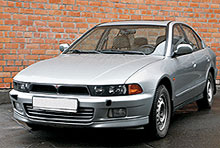 Simple discs are contraindicated
Simple discs are contraindicated The chassis of the previous gallant with an independent multi -link suspension provided good sled qualities, but it did not differ in particular endurance. Since the Galant of the current generation inherited the design of the chassis of the predecessor, the situation has not changed much
One of the weaknesses is the bearings of the hubs (all four), which on our roads are enough for an average of 45,000-60,000 km. Since the bearings are not supposed to be separately, you have to change the hubs assembly at $ 150 apiece. There is, however, a much cheaper non -original, but according to the services, this is thrown out money. It is noteworthy that the hub bearings are very critical to the departure of the wheelset, which should be 46 mm. Therefore, do not rush to rejoice by choosing beautiful non -original wheels suitable for landing sizes. If their departure is significantly different from the required, the hub may have to be changed on every second.
In the front suspension, the lower straight levers will most often require attention. The backlash in their hinges appears after 15,000 km, but Mitsubishi regulates not the presence of a backlash, but its value. Therefore, really levers, like hubs, nurse 45,000-60,000 km. Approximately the same amount of steering rods and tips. Here, backlash cannot be launched. Otherwise, they can break the steering rack, which is not included in the risk group. From unscheduled steering, it is possible to note the flow of a hydraulic power pipe, which can appear in Moscow salt in four years. But this is a trifle.
But other details of the pendants, on the contrary, turned out to be more durable than we could assume. In the front, all levers, except the lower lines, change after 100,000 km. And for the lower longitudinal levers of the rear suspension, mechanics are generally difficult to name any specific service life. They say that up to 150,000 km, they are replaced only after blows.
Another favorite callus is brake discs. Ideally, they withstand three sets of pads. But, unfortunately, discs are very prone to beating, causing vibration during braking. Usually they have to be grinded before each replacement of the pads, or even more often. Therefore, as a rule, the discs must be changed after the second kit. In this case, it makes sense to use high -quality non -original - both wheels and pads. In addition, on each it is necessary to clean and lubricate the brake calipers. It is cheaper than repairing and, moreover, to change the jammed caliper.
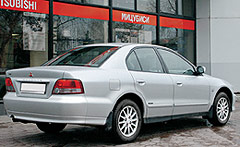 Buy?
Buy? Let's summarize. In general, Galant is a rather reliable car that will rarely plunge you into unforeseen expenses. A real weak place in the car is the chassis. Every 45-60 thousand km to replace hubs, straight levers, front brake discs and steering rods with tips will have to be laid out $ 1100-1300. On the one hand, the amount is decent. But what is the alternative?
European classmates in the aggregate of operating costs will cost at least not cheaper. Yes, spare parts for them are not so expensive, but Europeans break incomparably more often. Among the Japanese cars, Galanta still needs to record Camrei and Maxim - whatever one may say, he is older than Avensis and examples. In terms of endurance of Toyota and Nissan, they clearly beat Galant. But they are more expensive, especially with 6-cylinder engines. In addition, both Kamri and Maxim are the right cars that do not cause any emotions. And those who need a Japanese BMW look closely at Galant. Therefore, if you like it, you will buy it anyway.
The situation with prices is as follows. The 1999 Galant of the 1999 Galant costs $ 12,500-4,000 with a 2-liter engine and $ 15,000-17,000 with V6. A car of the same age, running 80,000-100,000 km along our roads, should cost thousands of one and a half or two cheaper.
A source: Magazine "Limousine" [12/02]
Video Test Drive Mitsubishi Galant 1997 - 2004
Video Crash tests Mitsubishi Galant 1997 - 2004
Test drives Mitsubishi Galant 1997 - 2004
Malfunctions Mitsubishi Galant 1997 - 2004
Mitsubishi Galant malfunctions: Detailed information| Galant 1997 - 2004 | |
|---|---|
| Engine |  |
| Transmission |  |
| Control system and suspension |  |
| Brake system |  |
| Air heating and air conditioning |  |
| Launch and charging system |  |
| Electric components and so on |  |
| Corrosion body stability |  |










